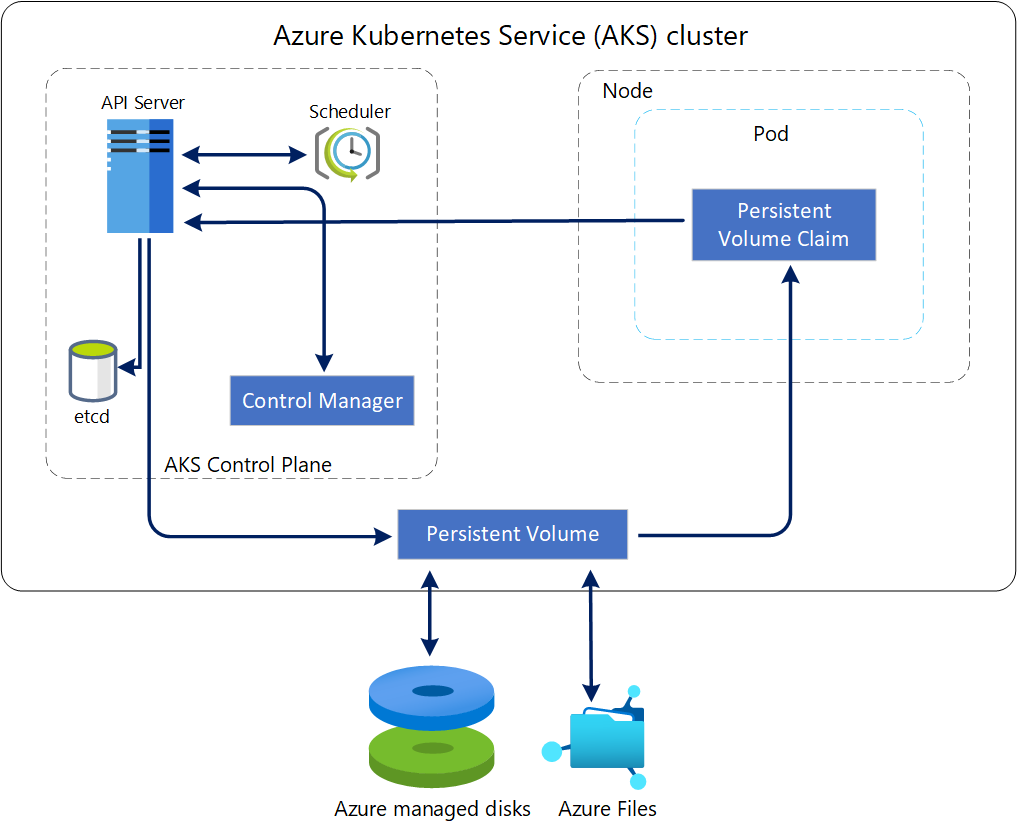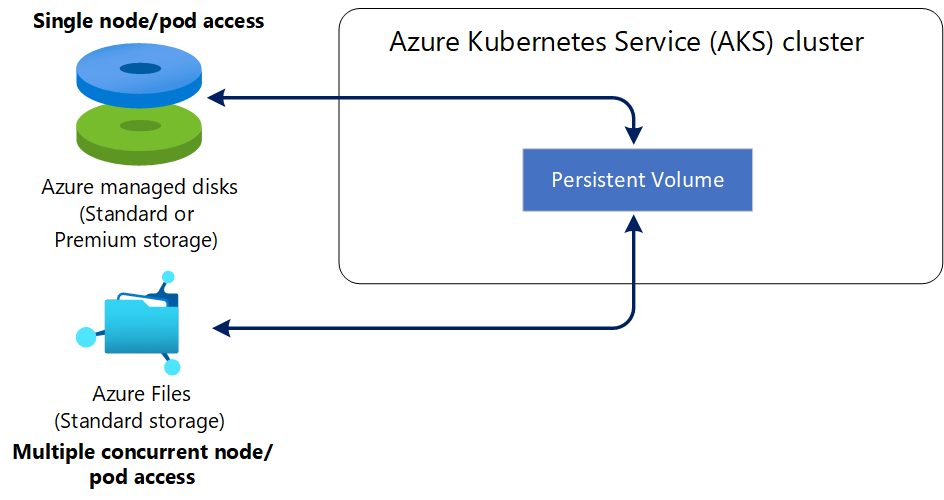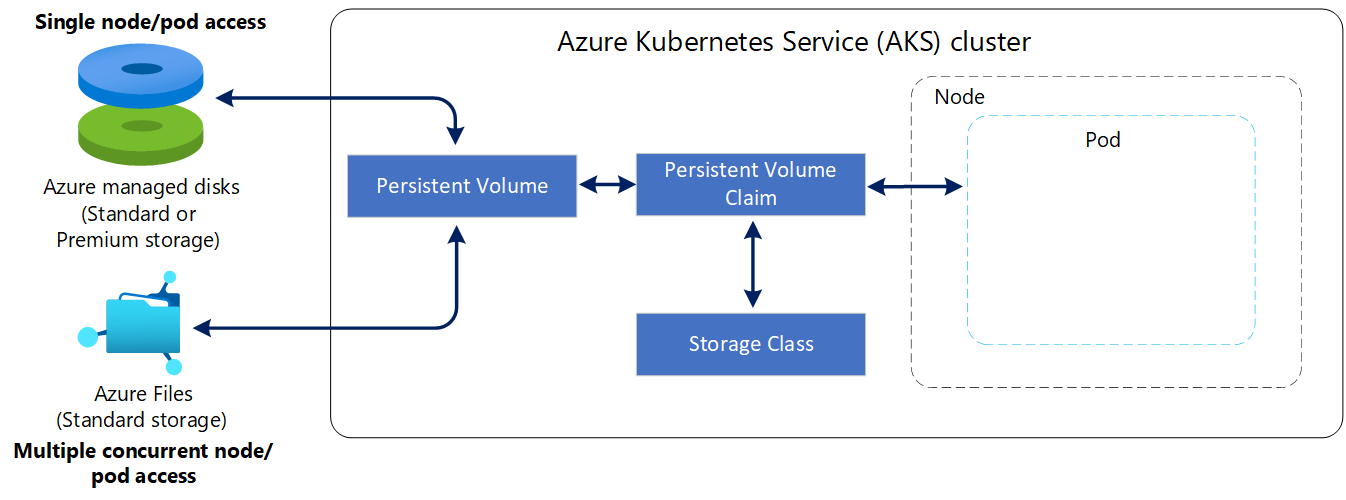Note
Access to this page requires authorization. You can try signing in or changing directories.
Access to this page requires authorization. You can try changing directories.
Applications running in Azure Kubernetes Service (AKS) might need to store and retrieve data. While some application workloads can use local, fast storage on unneeded, emptied nodes, others require storage that persists on more regular data volumes within the Azure platform.
Multiple pods might need to:
- Share the same data volumes.
- Reattach data volumes if the pod is rescheduled on a different node.
You also might need to collect and store sensitive data or application configuration information into pods.
This article introduces the core concepts that provide storage to your applications in AKS:

Default OS disk sizing
Ephemeral OS disks
If you select a VM SKU that supports Ephemeral OS disks but don't specify an OS disk size, AKS by default provisions an Ephemeral OS disk with a size that scales according to the total temp storage of the VM SKU so long as the temp is at least 128GiB. For example, the Standard_D8ds_v5 SKU with a temp disk size of 300GiB will receive a 300GiB Ephemeral OS disk by default if the disk parameters are unspecified.
If you want to use the temp storage of the VM SKU, you need to specify the OS disk size during deployment, otherwise it's consumed by default.
Important
Default Ephemeral OS disk sizing is only used on new clusters or node pools where Ephemeral OS disks are supported and a default OS disk size isn't specified. The default OS disk size might impact the performance or cost of your cluster. You can't change the OS disk size after cluster or node pool creation. This default Ephemeral sizing affects clusters or node pools created in March 2025 or later.
Managed OS disks
When you create a new cluster or add a new node pool to an existing cluster, the number for vCPUs by default determines the OS disk size. The number of vCPUs is based on the VM SKU. The following table lists the default OS disk size for each VM SKU:
| VM SKU Cores (vCPUs) | Default OS Disk Tier | Provisioned IOPS | Provisioned Throughput (Mbps) |
|---|---|---|---|
| 1 - 7 | P10/128G | 500 | 100 |
| 8 - 15 | P15/256G | 1100 | 125 |
| 16 - 63 | P20/512G | 2300 | 150 |
| 64+ | P30/1024G | 5000 | 200 |
Important
Default Managed OS disk sizing is only used on new clusters or node pools when Ephemeral OS disks aren't supported and a default OS disk size isn't specified. The default OS disk size might impact the performance or cost of your cluster. You can't change the OS disk size after cluster or node pool creation. We recommend a minimum disk size of 512G if ephemeral OS disk cannot be used. This default Managed sizing affects clusters or node pools created in July 2022 or later.
Ephemeral OS disk
By default, Azure automatically replicates the operating system disk for a virtual machine to Azure Storage to avoid data loss when the VM is relocated to another host. However, since containers aren't designed to have local state persisted, this behavior offers limited value while providing some drawbacks. These drawbacks include, but aren't limited to, slower node provisioning and higher read/write latency.
By contrast, Ephemeral OS disks are stored only on the host machine, just like a temporary disk. With this configuration, you get lower read/write latency with faster node scaling and cluster upgrades. Therefore, we strongly recommend using Ephemeral OS disks whenever possible.
Note
When you don't explicitly request Azure managed disks for the OS, AKS defaults to ephemeral OS if possible for a given node pool configuration.
Size requirements and recommendations for ephemeral OS disks are available in the Azure VM documentation. The following are some general sizing considerations:
If you chose to use the AKS default VM size Standard_DS2_v2 SKU with the default OS disk size of 100 GiB, the default VM size supports ephemeral OS, but only has 86 GiB of cache size. This configuration would default to managed disks if you don't explicitly specify it. If you do request an ephemeral OS, you receive a validation error.
If you request the same Standard_DS2_v2 SKU with a 60-GiB OS disk, this configuration would default to ephemeral OS. The requested size of 60 GiB is smaller than the maximum cache size of 86 GiB.
If you select the Standard_D8s_v3 SKU with 100-GB OS disk, this VM size supports ephemeral OS and has 200 GiB of cache space. If you don't specify the OS disk type, the node pool would receive ephemeral OS by default.
The latest generation of VM series doesn't have a dedicated cache, but only temporary storage. For example, if you selected the Standard_E2bds_v5 VM size with the default OS disk size of 100 GiB, it supports ephemeral OS disks, but only has 75 GB of temporary storage. This configuration would default to managed OS disks if you don't explicitly specify it. If you do request an ephemeral OS disk, you receive a validation error.
If you request the same Standard_E2bds_v5 VM size with a 60-GiB OS disk, this configuration defaults to ephemeral OS disks. The requested size of 60 GiB is smaller than the maximum temporary storage of 75 GiB.
If you select Standard_E4bds_v5 SKU with 100-GiB OS disk, this VM size supports ephemeral OS and has 150 GiB of temporary storage. If you don't specify the OS disk type, by default Azure provisions an ephemeral OS disk to the node pool.
Customer-managed keys
You can manage encryption for your ephemeral OS disk with your own keys on an AKS cluster. For more information, see Use Customer Managed key with Azure disk on AKS.
Volumes
Kubernetes typically treats individual pods as ephemeral, disposable resources. Applications have different approaches available to them for using and persisting data. A volume represents a way to store, retrieve, and persist data across pods and through the application lifecycle.
Traditional volumes are created as Kubernetes resources backed by Azure Storage. You can manually create data volumes to be assigned to pods directly or have Kubernetes automatically create them. Data volumes can use: Azure Disk, Azure Files, [Azure NetApp Files][azure-netapp-files-service-levels], or Azure Blobs.
Note
Depending on the VM SKU you're using, the Azure Disk CSI driver might have a per-node volume limit. For some high performance VMs (for example, 16 cores), the limit is 64 volumes per node. To identify the limit per VM SKU, review the Max data disks column for each VM SKU offered. For a list of VM SKUs offered and their corresponding detailed capacity limits, see General purpose virtual machine sizes.
Azure Disk
Use Azure Disk to create a Kubernetes DataDisk resource. Disks types include:
- Premium SSDs (recommended for most workloads)
- Standard SSDs
- Standard HDDs
Tip
For most production and development workloads, use Premium SSDs.
Because an Azure Disk is mounted as ReadWriteOnce, it's only available to a single node. For storage volumes accessible by pods on multiple nodes simultaneously, use Azure Files.
Azure Files
Use Azure Files to mount a Server Message Block (SMB) version 3.1.1 share or Network File System (NFS) version 4.1 share. Azure Files let you share data across multiple nodes and pods and can use:
- Azure Premium storage backed by high-performance SSDs
- Azure Standard storage backed by regular HDDs
Azure Blob Storage
Use Azure Blob Storage to create a blob storage container and mount it using the NFS v3.0 protocol or BlobFuse.
- Block blobs
Volume types
Kubernetes volumes represent more than just a traditional disk for storing and retrieving information. Kubernetes volumes can also be used as a way to inject data into a pod for use by its containers.
Common volume types in Kubernetes include:
emptyDir
Commonly used as temporary space for a pod. All containers within a pod can access the data on the volume. Data written to this volume type persists only for the lifespan of the pod. Once you delete the pod, the volume is deleted. This volume typically uses the underlying local node disk storage, though it can also exist only in the node's memory.
secret
You can use secret volumes to inject sensitive data into pods, such as passwords.
- Create a secret using the Kubernetes API.
- Define your pod or deployment and request a specific secret.
- Secrets are only provided to nodes with a scheduled pod that requires them.
- The secret is stored in tmpfs, not written to disk.
- When you delete the last pod on a node requiring a secret, the secret is deleted from the node's tmpfs.
- Secrets are stored within a given namespace and are only accessed by pods within the same namespace.
configMap
You can use configMap to inject key-value pair properties into pods, such as application configuration information. Define application configuration information as a Kubernetes resource, easily updated and applied to new instances of pods as they're deployed.
Like using a secret:
- Create a ConfigMap using the Kubernetes API.
- Request the ConfigMap when you define a pod or deployment.
- ConfigMaps are stored within a given namespace and are only accessed by pods within the same namespace.
Persistent volumes
Volumes defined and created as part of the pod lifecycle only exist until you delete the pod. Pods often expect their storage to remain if a pod is rescheduled on a different host during a maintenance event, especially in StatefulSets. A persistent volume (PV) is a storage resource created and managed by the Kubernetes API that can exist beyond the lifetime of an individual pod.
You can use the following Azure Storage services to provide the persistent volume:
- Azure Disk
- Azure Files
- [Azure Container Storage][azure-container-storage]
As noted in the Volumes section, the choice of Azure Disks or Azure Files is often determined by the need for concurrent access to the data or the performance tier.

A cluster administrator can statically create a persistent volume, or a volume can be created dynamically by the Kubernetes API server. If a pod is scheduled and requests storage that is currently unavailable, Kubernetes can create the underlying Azure Disk or File storage and attach it to the pod. Dynamic provisioning uses a storage class to identify what type of resource needs to be created.
Important
Persistent volumes can't be shared by Windows and Linux pods due to differences in file system support between the two operating systems.
Storage classes
To specify different tiers of storage, such as premium or standard, you can create a storage class.
A storage class also defines a reclaim policy. When you delete the persistent volume, the reclaim policy controls the behavior of the underlying Azure Storage resource. The underlying resource can either be deleted or kept for use with a future pod.
For clusters using the Container Storage Interface (CSI) drivers the following extra storage classes are created:
| Storage class | Description |
|---|---|
managed-csi |
Uses Azure StandardSSD locally redundant storage (LRS) to create a managed disk. The reclaim policy ensures that the underlying Azure Disk is deleted when the persistent volume that used it is deleted. The storage class also configures the persistent volumes to be expandable. You can edit the persistent volume claim to specify the new size. |
managed-csi-premium |
Uses Azure Premium locally redundant storage (LRS) to create a managed disk. The reclaim policy again ensures that the underlying Azure Disk is deleted when the persistent volume that used it is deleted. Similarly, this storage class allows for persistent volumes to be expanded. |
azurefile-csi |
Uses Azure Standard storage to create an Azure file share. The reclaim policy ensures that the underlying Azure file share is deleted when the persistent volume that used it is deleted. |
azurefile-csi-premium |
Uses Azure Premium storage to create an Azure file share. The reclaim policy ensures that the underlying Azure file share is deleted when the persistent volume that used it is deleted. |
azureblob-nfs-premium |
Uses Azure Premium storage to create an Azure Blob storage container and connect using the NFS v3 protocol. The reclaim policy ensures that the underlying Azure Blob storage container is deleted when the persistent volume that used it is deleted. |
azureblob-fuse-premium |
Uses Azure Premium storage to create an Azure Blob storage container and connect using BlobFuse. The reclaim policy ensures that the underlying Azure Blob storage container is deleted when the persistent volume that used it is deleted. |
Unless you specify a storage class for a persistent volume, the default storage class is used. Ensure volumes use the appropriate storage you need when requesting persistent volumes.
Important
Starting with Kubernetes version 1.21, AKS uses CSI drivers by default, and CSI migration is enabled. While existing in-tree persistent volumes continue to function, starting with version 1.26, AKS will no longer support volumes created using in-tree driver and storage provisioned for files and disk.
The default class will be the same as managed-csi.
You can create a storage class for other needs using kubectl. The following example uses premium managed disks and specifies that the underlying Azure Disk should be retained when you delete the pod:
apiVersion: storage.k8s.io/v1
kind: StorageClass
metadata:
name: managed-premium-retain
provisioner: disk.csi.azure.com
parameters:
skuName: Premium_LRS
reclaimPolicy: Retain
volumeBindingMode: WaitForFirstConsumer
allowVolumeExpansion: true
Note
AKS reconciles the default storage classes and will overwrite any changes you make to those storage classes.
For more information about storage classes, see StorageClass in Kubernetes.
Persistent volume claims
A persistent volume claim (PVC) requests storage of a particular storage class, access mode, and size. The Kubernetes API server can dynamically provision the underlying Azure Storage resource if no existing resource can fulfill the claim based on the defined storage class.
The pod definition includes the volume mount once the volume has been connected to the pod.

Once an available storage resource has been assigned to the pod requesting storage, the persistent volume is bound to a persistent volume claim. Persistent volumes are mapped to claims in a 1:1 mapping.
The following example YAML manifest shows a persistent volume claim that uses the managed-premium storage class and requests an Azure Disk that is 5Gi in size:
apiVersion: v1
kind: PersistentVolumeClaim
metadata:
name: azure-managed-disk
spec:
accessModes:
- ReadWriteOnce
storageClassName: managed-premium-retain
resources:
requests:
storage: 5Gi
When you create a pod definition, you also specify:
- The persistent volume claim to request the desired storage.
- The volume mount for your applications to read and write data.
The following example YAML manifest shows how the previous persistent volume claim can be used to mount a volume at /mnt/azure:
kind: Pod
apiVersion: v1
metadata:
name: nginx
spec:
containers:
- name: myfrontend
image: mcr.azk8s.cn/oss/nginx/nginx:1.15.5-alpine
volumeMounts:
- mountPath: "/mnt/azure"
name: volume
volumes:
- name: volume
persistentVolumeClaim:
claimName: azure-managed-disk
For mounting a volume in a Windows container, specify the drive letter and path. For example:
...
volumeMounts:
- mountPath: "d:"
name: volume
- mountPath: "c:\k"
name: k-dir
...
Next steps
For associated best practices, see Best practices for storage and backups in AKS.
For more information on using CSI drivers, see the following articles:
- Container Storage Interface (CSI) drivers for Azure Disk, Azure Files, and Azure Blob storage on Azure Kubernetes Service
- Use Azure Disk CSI driver in Azure Kubernetes Service
- Use Azure Files CSI driver in Azure Kubernetes Service
- Use Azure Blob storage CSI driver in Azure Kubernetes Service
For more information on core Kubernetes and AKS concepts, see the following articles: